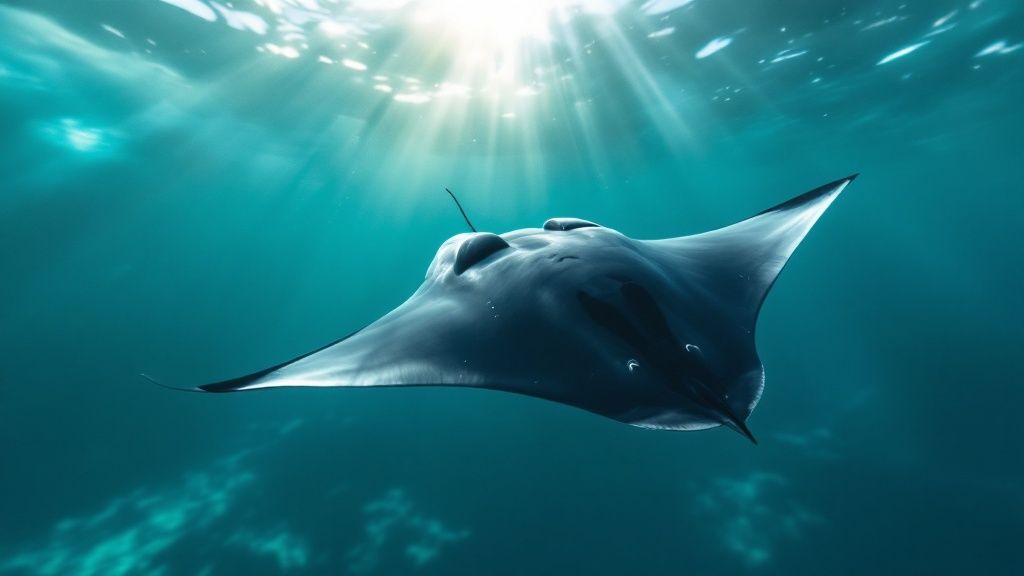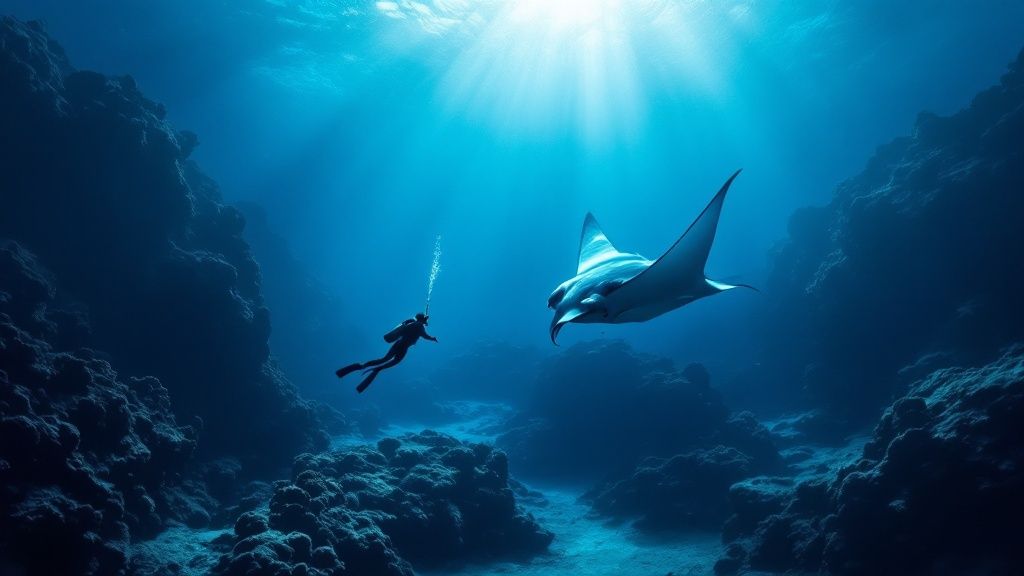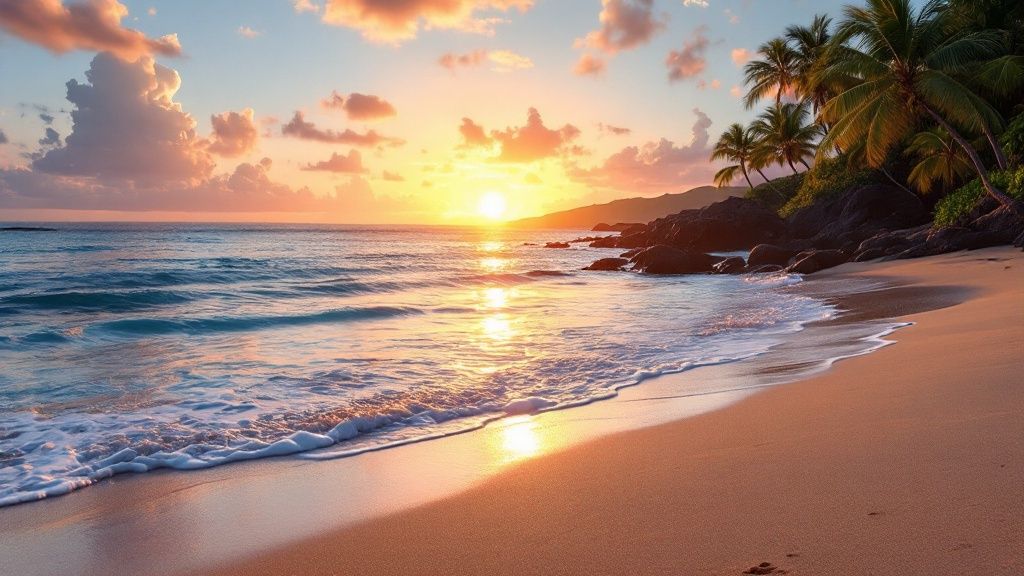The Mesmerizing World of Manta Ray Kona Hawaii

Swimming with manta rays in Kona, Hawaii is an unforgettable experience. What makes this location a global hotspot for these gentle giants? The answer lies in the unique environment, creating ideal conditions for reliable manta ray sightings. Visitors consistently rank this as one of their most memorable wildlife interactions.
The nutrient-rich waters off the Kona coast, particularly Keauhou Bay and Garden Eel Cove, attract manta rays. These locations offer abundant plankton, their primary food source. Learn more about Kona Manta Dives.
This readily available food combined with clear, warm waters allows mantas to thrive. The unique ocean floor topography also plays a crucial role. The combination of food and favorable conditions creates predictable manta ray activity, making Kona a prime viewing spot.
Manta rays in Kona are part of a larger global population known for their long migrations. Two species are commonly found in Hawaiian waters: the reef manta ray (Mobula alfredi) and the giant manta ray (Mobula birostris). Learn more about manta rays here. These gentle giants are primarily drawn to areas to feed on plankton, especially at night.
Why Choose a Manta Ray Night Snorkel?
This nocturnal behavior provides the perfect setting for the popular manta ray night snorkel. As darkness falls, specialized lights attract plankton, creating a “buffet” for the manta rays.
This predictable feeding pattern allows snorkelers and divers to witness these graceful creatures gliding through the illuminated water.
Responsible Tourism and Conservation
Manta ray tours in Kona have spurred a focus on responsible tourism. Reputable tour operators prioritize sustainable practices, minimizing disturbance to the manta rays and their environment. Find the best time to see manta rays.
These operators often educate visitors about manta ray conservation. Check out Kona Honu Divers Manta Ray Snorkeling Tours. Learn more at Manta Ray Night Snorkel Hawaii. Find great tours at Kona Snorkel Trips. This combination of unforgettable experiences and responsible tourism ensures future generations can enjoy the manta rays. See more options with Captain Cook Snorkeling Tours. This commitment to sustainability benefits both the manta rays and the local economy.
Prime Manta Ray Viewing Spots Along Kona's Coast

Kona, Hawaii, is a world-renowned destination for manta ray encounters. These graceful giants glide through the Pacific, captivating visitors with their impressive wingspans and gentle nature. But with so many potential viewing locations, where should you head for the best chance of a magical experience? This guide will highlight some prime spots along the Kona coast, each with its unique characteristics.
Keauhou Bay: The Famous Manta Village
Keauhou Bay, affectionately nicknamed Manta Village, stands out as perhaps the most famous manta ray viewing location. The bay's shallow, sandy bottom, combined with regular plankton blooms, creates an ideal feeding ground for these magnificent creatures.
This makes it a particularly attractive spot for manta rays, and therefore, for those wishing to observe them. The relatively calm and clear waters also offer excellent visibility, perfect for both seasoned divers and families with young children. For more information on manta ray night snorkeling excursions, check out our guide on Manta Ray Night Snorkeling on the Big Island.
Garden Eel Cove: A Manta Ray Haven
Just north of Keauhou Bay, you'll find Garden Eel Cove, sometimes referred to as Manta Heaven. While access can be a bit more challenging depending on the ocean conditions, the potential rewards are well worth the effort.
This cove boasts a unique underwater topography that concentrates plankton, attracting a large number of manta rays. Experienced snorkelers and divers often favor Garden Eel Cove for the opportunity to witness more dynamic manta ray feeding behaviors.
Other Notable Locations Along the Kona Coast
Beyond Keauhou Bay and Garden Eel Cove, Kona offers several other remarkable manta ray viewing spots. These lesser-known gems can provide a more intimate experience, often with fewer crowds.
- Makako Bay: Known for its calmer waters and diverse marine life, Makako Bay offers a chance to see manta rays in a more natural setting.
- Sheraton Kona Resort: The lights from this resort attract plankton, occasionally drawing manta rays closer to shore.
To help you choose the best spot for your manta ray adventure, we've compiled a comparison table:
To help you choose the perfect spot, we've created this helpful table comparing the different locations:
Manta Ray Viewing Locations in Kona
Comparison of the main manta ray viewing sites along the Kona coast with key information about each location
| Location | Best Time | Access Method | Success Rate | Experience Level |
|---|---|---|---|---|
| Keauhou Bay (Manta Village) | Night | Boat/Snorkel/Dive | High | Beginner – Advanced |
| Garden Eel Cove (Manta Heaven) | Night | Boat/Snorkel/Dive | High | Intermediate – Advanced |
| Makako Bay | Day/Night | Boat/Snorkel/Dive | Moderate | Beginner – Advanced |
| Sheraton Kona Resort | Night | Shore/Snorkel | Moderate | Beginner – Advanced |
As you can see, each location offers a unique experience. Keauhou Bay provides easy access for all levels, while Garden Eel Cove may be better suited for more experienced adventurers.
Choosing the Right Spot For Your Manta Ray Adventure
Selecting the ideal viewing location depends on your experience level and preferences. Beginners may find the calm waters and easy access of Keauhou Bay more suitable. More experienced snorkelers and divers, seeking potentially larger manta ray gatherings, might prefer Garden Eel Cove.
Remember, while manta ray sightings are never guaranteed, Kona's unique environment offers some of the best viewing opportunities in the world. Each location offers a unique perspective on these majestic creatures, ensuring a memorable Kona, Hawaii manta ray experience.
The Fascinating Biology Behind Manta Ray Kona Hawaii

What makes manta rays so captivating? Their sheer size is impressive, of course. But these graceful giants are so much more than that. They are oceanic acrobats, their remarkable adaptations and behaviors honed over millions of years.
Their intelligence, for instance, is truly remarkable. Mantas possess the largest brain-to-body ratio of any fish. This intelligence contributes to their inherent curiosity, often observed in their interactions with humans, making manta ray Kona Hawaii encounters even more special.
Understanding the Manta Ray's Feeding Patterns
The science behind how manta rays feed is fascinating. Plankton, their primary food source, is attracted to strategically placed lights, creating a mesmerizing feeding frenzy. These lights, used during night dives and snorkeling trips, aren't just for our benefit. They play a crucial role in the manta ray's feeding ritual. This creates an unparalleled opportunity to observe these magnificent creatures, particularly on the popular manta ray Kona Hawaii night tours.
Unique Physical Attributes of the Manta Ray
Manta rays possess a unique set of physical characteristics. Their distinctive markings, as individual as fingerprints, allow researchers to identify and track individuals. Manta Ray Heaven: Garden Eel Cove offers a glimpse into their world. This long-term monitoring provides valuable data about their behavior and lifespans.
Their wingspan, reaching up to an incredible 20 feet, contributes to their graceful, ballet-like movements. Since 1991, research in Kona, Hawaii, has identified over 290 unique individuals based on their ventral spot patterns. The first identified manta was named "Lefty," beginning a comprehensive cataloging effort. Learn more about the ongoing Manta Ray Research.
The Importance of Biological Understanding
Understanding the biology of the manta ray transforms a simple sighting into a deep appreciation of these evolutionary marvels. From their feeding habits to their unique markings, every aspect of their biology adds to the wonder of a manta ray Kona Hawaii encounter.
This knowledge enhances the experience, allowing a greater appreciation of witnessing these creatures in their natural habitat. Several reputable tour operators, such as Kona Honu Divers, Manta Ray Night Snorkel Hawaii, Kona Snorkel Trips, and Captain Cook Snorkeling Tours, offer quality manta ray Kona Hawaii experiences.
Selecting Your Perfect Manta Ray Kona Hawaii Tour

Not all manta ray tours in Kona, Hawaii are the same. Choosing the right one can significantly impact your overall experience. Understanding the differences between an exceptional tour and a mediocre one is key to a truly unforgettable encounter with these gentle giants. Factors like group size, equipment quality, and guide expertise play a major role. For more information on why a manta ray dive in Kona is a must-do, check out this article: Why you should go on a manta ray dive in Kona.
Group Size: Intimacy vs. Crowds
Smaller groups provide a more intimate and personalized experience. This allows for greater interaction with the manta rays and more individual attention from your guides. Larger groups, while potentially more budget-friendly, can sometimes feel crowded and less focused on observing the animals.
Equipment Quality: Enhancing Your View
High-quality masks, snorkels, and wetsuits directly impact your comfort and underwater visibility. Well-maintained gear ensures a crystal-clear view of the majestic manta rays. It also helps you stay warm and comfortable throughout your tour. Some operators even offer specialized equipment like underwater lights. These lights can enhance plankton visibility, which in turn attracts the manta rays.
Guide Expertise: Safety and Knowledge
Experienced guides are essential for a successful manta ray tour. Their deep knowledge of manta ray behavior and the local environment helps maximize your sighting opportunities. A knowledgeable guide can point out subtle cues, like sounds and sensations, that indicate an approaching manta ray. They also prioritize safety, ensuring a comfortable and secure experience, especially for first-time snorkelers or those with anxieties about night-water activities.
Comparing Kona's Top Manta Ray Tour Operators
To help you choose the best tour, we've compiled a comparison of some of Kona's leading manta ray tour operators. This table highlights key differences in group sizes, experiences offered, equipment provided, price ranges, and any extra perks.
| Tour Operator | Group Size | Experience Types | Equipment Provided | Price Range | Extras |
|---|---|---|---|---|---|
| Kona Honu Divers | Varies | Snorkel/Dive | High-quality rentals available | Varies | Focus on safety and education |
| Manta Ray Night Snorkel Hawaii | Varies | Snorkel | Included | Varies | Experienced crew |
| Kona Snorkel Trips | Varies | Snorkel | Included | Varies | Multiple tour options |
| Captain Cook Snorkeling Tours | Varies | Snorkel/Dive | Included | Varies | Variety of locations |
As you can see, each tour operator offers a unique experience. Considering factors like group size, equipment quality, and guide expertise will help you select the perfect manta ray Kona Hawaii tour that meets your needs and preferences. Choosing the right tour maximizes your chances of a memorable and enriching experience with these incredible creatures in their natural habitat.
Preparing For An Unforgettable Manta Ray Kona Hawaii Swim
Getting ready for a manta ray swim in Kona, Hawaii is about more than just packing your swimsuit. A little preparation, both physically and mentally, can make a big difference in how much you enjoy this incredible experience. Here's a guide to help you get ready.
What to Wear and Bring
While a swimsuit is essential, a rash guard or wetsuit can provide extra warmth and protection from the sun, especially since the ocean can be cooler at night. Don't forget a towel and a waterproof bag for your personal belongings. If you need to rent equipment, Kona Honu Divers offers high-quality rentals.
Comfort and Confidence in the Water
If you’re not used to swimming in the ocean or feel a bit anxious about being in the water at night, practicing some basic water skills beforehand can be beneficial. This will build your confidence and allow you to fully immerse yourself in the experience. Keep in mind that reputable tour operators like Manta Ray Night Snorkel Hawaii prioritize safety and provide experienced guides.
Optimizing Your Manta Ray Viewing
To get the best views of the manta rays, positioning yourself correctly in the water is key. Try to float horizontally and avoid splashing or making sudden movements. Your guide will offer advice on the best positions and how to use your flashlight effectively. Kona Snorkel Trips offers a variety of tours to choose from based on your preferences.
Underwater Photography Tips
If you plan on taking photos or videos, remember that capturing these magnificent creatures requires a respectful approach. Use a red light or turn off your flash to avoid disturbing the manta rays and the plankton they feed on. Respecting their natural environment is crucial. Consider Captain Cook Snorkeling Tours for exploring various viewing locations.
Understanding Manta Ray Signals
Learning a few things about manta ray behavior can add another dimension to your experience. Experienced guides can point out subtle cues that indicate an approaching manta ray, like the sound of rushing water or a change in the surrounding plankton density. This awareness can heighten the thrill of the encounter.
By following these simple tips, you can turn any pre-swim jitters into excitement and ensure an unforgettable manta ray encounter in Kona, Hawaii. This experience offers a unique connection with nature, deepening your appreciation for the wonders of the ocean.
Manta Rays in Hawaiian Cultural Heritage
Manta rays off the coast of Kona, Hawaii, are a breathtaking sight. But their significance goes beyond mere natural beauty; they hold a special place in the islands' cultural heritage. This deep connection transforms any manta ray encounter into a truly meaningful experience.
Aumakua: The Ancestral Guardians
The term aumakua in Hawaiian culture refers to ancestral guardians that can manifest in various forms, including animals. Some Hawaiian families revere manta rays as aumakua, believing them to be powerful spiritual protectors watching over their lineage. This belief instills a profound respect for these graceful creatures.
The Kumulipo and Hāhālua: Ancient Connections
This reverence is echoed in the kumulipo, the Hawaiian creation chant. The chant’s mention of manta rays reinforces their vital role in Hawaiian cosmology. The Hawaiian name for manta ray, hāhālua, translates to "two breaths or mouths." This name likely describes either their unique filter-feeding process or their prominent cephalic fins. Witnessing these creatures in their natural environment becomes even more significant when viewed through this cultural lens.
Kuleana and Mālama: Guiding Conservation
Traditional Hawaiian values underpin modern conservation efforts. Kuleana (responsibility) and mālama (to care for) inform responsible tourism and community-based initiatives to protect manta rays and their delicate habitat. Their estimated lifespan of 40 to 50 years combined with slow reproduction rates highlights the urgency of these protective measures. Learn more about the cultural significance of manta rays.
Experiencing Manta Rays Through a Cultural Lens
Understanding the cultural significance of manta rays enriches any encounter, connecting you to Hawaiian heritage. Various tour operators offer excursions that incorporate this cultural perspective. Some popular options include Kona Honu Divers, Manta Ray Night Snorkel Hawaii, Kona Snorkel Trips, and Captain Cook Snorkeling Tours. This cultural awareness fosters a deeper appreciation for these gentle giants and inspires a commitment to their preservation for generations to come. It emphasizes the beautiful interplay between culture and nature, making the experience truly unforgettable.
Conservation Efforts Supporting Manta Ray Kona Hawaii
Kona, Hawaii, is renowned for its incredible manta ray population. Maintaining this delicate ecosystem requires a balance between sharing these magnificent creatures with visitors and ensuring their long-term survival. This means understanding the challenges they face and actively supporting the ongoing efforts to protect them.
Research and Monitoring Efforts
Understanding manta ray populations is key to effective conservation. Scientists are actively engaged in research, tracking population numbers, studying migration patterns, and assessing the impact of environmental changes. This work provides essential data for informing conservation strategies and safeguarding the future of these gentle giants.
This research helps identify potential risks and guides effective conservation practices. Analyzing the data collected allows researchers to better understand the health and stability of the manta ray population. For further insights into these initiatives, read our Open Letter to Hawaii State DLNR Regarding Manta Rules.
Responsible Tourism's Role
Responsible tourism plays a vital role in manta ray conservation. Tour operators who prioritize sustainable practices are key to this effort. By educating visitors and implementing responsible viewing guidelines, they minimize disturbance to the manta rays and their habitat.
These sustainable tours also create economic benefits for local communities, providing further incentive for protection. Direct contributions from tour operators often fund vital research and conservation programs.
Addressing Threats and Implementing Solutions
Manta rays face a variety of threats, from fishing gear entanglement to the effects of climate change. Changes in plankton availability, their primary food source, also impact their well-being.
However, there's hope. Innovative solutions are being implemented to mitigate these challenges. These include promoting sustainable fishing gear and supporting research to understand and address the effects of a changing climate.
How You Can Contribute
You can play a part in protecting manta rays, even after your visit. Supporting research organizations through donations is a significant contribution. You can also advocate for responsible tourism and educate others about the importance of manta ray conservation.
Every action, no matter how small, helps ensure these magnificent creatures thrive in Hawaiian waters for generations to come.
Ready for an unforgettable manta ray encounter? Book your adventure with Kona Honu Divers! Explore our Manta Ray Dive and Snorkel Tours and create memories that will last a lifetime.
